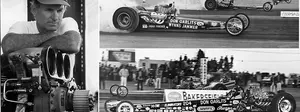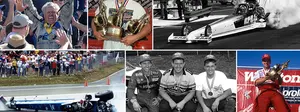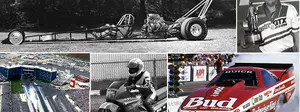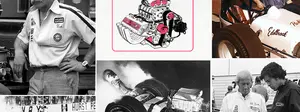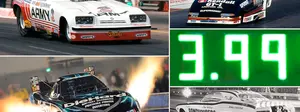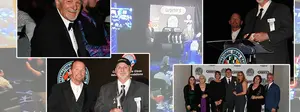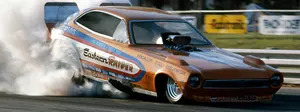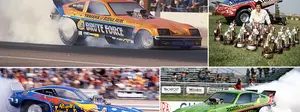

April Fools 1998: Nitro trucks, twin-engine Top Fuelers, and rear-engined Pro Stockers

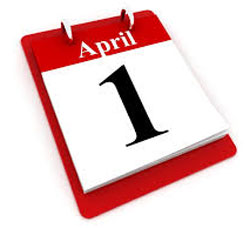 In case you forgot, Sunday is April 1, or April Fool’s Day, which around these parts used to be a pretty big deal. From the late 1990s through the mid-2000s, NHRA.com annually presented a special April Fools section with funny (yet often plausible) news stories that sometimes were believed but always were enjoyed by our readers. Yes, race fans, we were Fake News before it became a thing.
In case you forgot, Sunday is April 1, or April Fool’s Day, which around these parts used to be a pretty big deal. From the late 1990s through the mid-2000s, NHRA.com annually presented a special April Fools section with funny (yet often plausible) news stories that sometimes were believed but always were enjoyed by our readers. Yes, race fans, we were Fake News before it became a thing.
It started innocently enough, when a talented graphic designer named Jim Billups approached me in early 1998 with the idea to use PhotoShop to modify some existing race car photos into futuristic designs. I don’t recall if it was proposed as a “what if?” kind of thing that we turned into an April Fools special that fooled many people (and created a great bit of outrage). I think what made it such a big deal was that, at the time PhotoShop wasn’t being used by everyone and Jim was so far ahead of the skillset that no one could imagine these realistic images weren’t for real.Today I consider myself a pretty fair PhotoShop manipulator, but Jim's stuff was unreal (and forward-looking; tell me Cristen Powell's car doesn't remind you a bit of today's canopied dragsters), and the story we wrote to accompany it, along with fabricated quotes, just added to the illusion.
So, on the 20-year anniversary of that first prank, I’ve unearthed the original story and photos (not easy to find, believe it or not) to share here, followed by a list of some other gems. In the eight years that followed, before the racing schedule (hard to make a fake story the top story on a race weekend) and political correctness forced an end to the shenanigans, myself and my former NHRA.com cohort Rob Geiger turned out a slew of funny, sometimes biting April Fools stories, which you can review later in the column.
But here's the one that got it all started.
Nitro trucks, twin-engine TFs make test runs
4-1-98
by I.M. Soshure
Nitro "Thunder Trucks," an experimental new class, got its first serious track time in a series of top-secret test sessions conducted by NHRA in conjunction with several top teams at Pomona Raceway April 1.
The clandestine sessions were part of an ambitious program proposed by NHRA and heartily endorsed by the racers to explore workable new configurations in Top Fuel, Funny Car, and Pro Stock, as well as other potential new classes to capitalize on the current popularity of NHRA Drag Racing.
"We basically gave racers a clean sheet of paper and told them to bring us their best ideas," said an unnamed NHRA official. "As usual, we were amazed by their ingenuity and engineering skills."
Buoyed by the enthusiasm of NHRA's new Pro Stock Truck class, four teams brought nitro-powered, truck-influenced machines to Pomona, all sporting rear-engined configurations and radically reshaped truck bodies. Multi-engine Top Fuelers, a streamliner, a mid-engine Pro Stocker, and a four-door Pro Stocker were among the innovative machines present, but all eyes were on the "Thunder Trucks."
 Although none of the trucks made anything resembling a full run, they were impressive in their introductory launches and their exhilarating visual shapes.
Although none of the trucks made anything resembling a full run, they were impressive in their introductory launches and their exhilarating visual shapes.
John Force, naturally, was at the center of attention with his radical rear-engined Ford Ranger truck. The sleek Ford thundered the ground and the up-front driver placement gave Force a whole new perspective.
"It's a scary feeling," said the Winston champ. "There's a whole lot of race car out behind me in this ol' Hound Dog and it's weird not to be looking past that old huffer [blower] scoop. I'll have to learn a whole new way to drive, but it's exciting to be part of this new era in drag racing."
 Jim Dunn, whose Funny Car operation currently does not have a sponsor, hopes to attract a backer with his outrageous screaming-yellow Dodge Dakota, which also has driver Frank Pedregon sitting essentially on top of the front axle. Handling problems kept his passes to the 60-foot range, but Dunn, a pioneer in rear-engined Funny Cars who built the car himself, reportedly was pleased anyway.
Jim Dunn, whose Funny Car operation currently does not have a sponsor, hopes to attract a backer with his outrageous screaming-yellow Dodge Dakota, which also has driver Frank Pedregon sitting essentially on top of the front axle. Handling problems kept his passes to the 60-foot range, but Dunn, a pioneer in rear-engined Funny Cars who built the car himself, reportedly was pleased anyway.
 Dean Skuza took a similar approach but chose to use a Pro Stock-style "roof scoop" in place of a conventional injector.
Dean Skuza took a similar approach but chose to use a Pro Stock-style "roof scoop" in place of a conventional injector.
"We were concerned how air would travel up the nose of our truck," said Skuza. "We wanted the ram effect and wanted to make sure we still captured that air."
The new design did little to affect Skuza's driving style as he ripped off several eighth-mile burnouts made even prettier by the effect of smoke billowing out from beneath the long bed of the Matco Tools-sponsored machine.
 Al Hofmann dared to be different, carrying his new affiliation with Pontiac a step further than the others did by rolling out a rear-engined Pontiac Transport Montana van.
Al Hofmann dared to be different, carrying his new affiliation with Pontiac a step further than the others did by rolling out a rear-engined Pontiac Transport Montana van.
The black machine, which he dubbed "Force's Worst Nightmare," seemed to launch well but suffered from a high center of gravity, which caused the veteran handler a few anxious moments at the 300-foot mark. Nonetheless, the Umatilla, Fla., veteran says he is not discouraged.
"Anyone with luck can build a truck," he said, "but it takes a man to run a van."
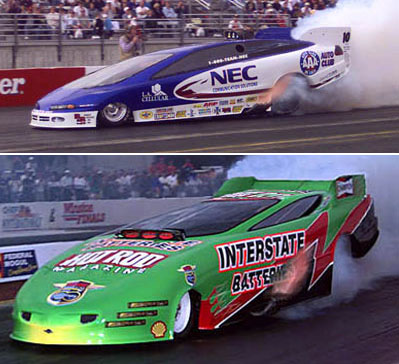 Gary Densham and Cruz Pedregon showed with conventional-setup floppers but with wild bodies. Densham's NEC machine featured a prototype "Avenger 3" body, dubbed after the long-rumored midship Dodge that has been on the drawing board for years. It's sleek blue shape caught everyone attention, and it's steady halftrack blasts were among the session's best.
Gary Densham and Cruz Pedregon showed with conventional-setup floppers but with wild bodies. Densham's NEC machine featured a prototype "Avenger 3" body, dubbed after the long-rumored midship Dodge that has been on the drawing board for years. It's sleek blue shape caught everyone attention, and it's steady halftrack blasts were among the session's best.
Pedregon and car owner Joe Gibbs were inspired by Gibbs' street machine, a Lamborghini Countach, and had Eerie Glass custom-make them a plastic Lambo. The eye-catching green machine looked fast even standing still, which it did little of. Crew chief Wes Cerny made no less than four runs during the daylong affair, putting particular interest in the body's handling characteristics.
Top Fuel power leaders Joe Amato and Alan Johnson also experimented at the event with multiple powerplants and multiple wheelsets.
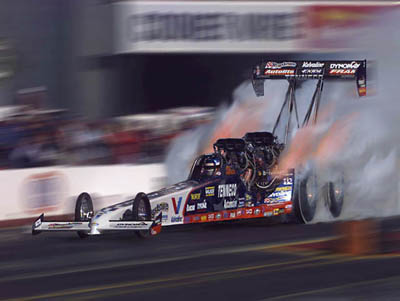 Amato stunned even those in attendance who had begun to think they'd seen it all when he finally rolled his Tenneco machine to the staging lanes under a full car cover. It was clear from its length and shape that something special was afoot, but when crew chief Jimmy Prock slipped the blue sheet off of Prock Rocket 2, an audible gasp rose from the assembled multitude of NHRA officials and members of other teams.
Amato stunned even those in attendance who had begun to think they'd seen it all when he finally rolled his Tenneco machine to the staging lanes under a full car cover. It was clear from its length and shape that something special was afoot, but when crew chief Jimmy Prock slipped the blue sheet off of Prock Rocket 2, an audible gasp rose from the assembled multitude of NHRA officials and members of other teams.
In a throwback to Top Gas days, Prock's 335-inch wheelbased dragster sports TWO engines, hooked together at the crankshaft, which then feed power to twin rear engines and six rear tires! The two rear ends are coupled through an innovative viscous fitting designed by noted fuel-part designer Jack Peteson.
Even with a light 70 percent mix of nitro, Amato's machine had no trouble almost melting the four rear tires off the blue and white machine. Apparently clutch technology lags behind this application.
"You know Jimmy," said Amato, affectionately rolling his eyes at his crew chief. "Give the kid free reign and he goes into light-speed mode."
 Johnson and driver Gary Scelzi wheeling last year's Team Winston dragster, rolled out their machine next, also fitted with a second rear end and two extra rear Goodyear tires but with only a conventional single engine.
Johnson and driver Gary Scelzi wheeling last year's Team Winston dragster, rolled out their machine next, also fitted with a second rear end and two extra rear Goodyear tires but with only a conventional single engine.
Although the car looked impressive, tire shake reared its ugly head on several runs, leading Johnson to speculate that the cure lay in more power, and indicated that he might follow Amato's cue and run twin engines.
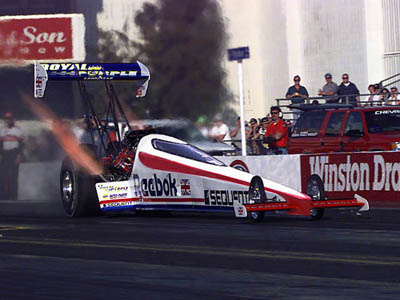 Cristen Powell showed with a conventional-by-comparison fueler, her 1997 chassis now wrapped in an aerodynamically sleek body adorned with Reebok sponsorship. Cristen steered her machine from an enclosed cockpit with wraparound glass but, like the others, limited her initial shots at the track to checkout passes. Her best run, a half-track shutoff, still netted an impressive 5.55.
Cristen Powell showed with a conventional-by-comparison fueler, her 1997 chassis now wrapped in an aerodynamically sleek body adorned with Reebok sponsorship. Cristen steered her machine from an enclosed cockpit with wraparound glass but, like the others, limited her initial shots at the track to checkout passes. Her best run, a half-track shutoff, still netted an impressive 5.55.
The body shape was designed by Reebok engineers, based on their extensive knowledge of wind-cutting shapes and advanced materials.
"Reebok has history of pushing the limits for design and function, so it's only natural that we show that same dedication on the racetrack," said Casey Powell. "We're encouraged by the early runs and definitely will continue to explore this new technology."
 Kurt Johnson's radical rear-engine Camaro Pro Stocker also caught the fancy of NHRA officials. The result of work between Johnson's father, Warren, and representatives of General Motors, which reportedly plans to unveil a rear-engine Z28 to the public in 2001, was an engineering marvel, from its center-driver location to roof-mounted scoop.
Kurt Johnson's radical rear-engine Camaro Pro Stocker also caught the fancy of NHRA officials. The result of work between Johnson's father, Warren, and representatives of General Motors, which reportedly plans to unveil a rear-engine Z28 to the public in 2001, was an engineering marvel, from its center-driver location to roof-mounted scoop.
Johnson seemed spooked by the car's unique handling characteristics and limited his efforts to two short squirts. The car hooked hard and it's light front weight made it prone to wheelstands.
"It's a different ride," said Johnson, the first Pro Stock driver to run in the sixes. "It will take some time to get used to it, and we obviously have some work to do on the four-link to calm it down. But, man, it sure looks fast, doesn't it?"
 Larry Nance took a page from the history books, too, with his four-door Cutlass, which elicited flashbacks to the Gapp & Roush four-door Mavericks of the early 1970s.
Larry Nance took a page from the history books, too, with his four-door Cutlass, which elicited flashbacks to the Gapp & Roush four-door Mavericks of the early 1970s.
The machine, built on a standard Pro Stock frame by Barry Jickel, was neat to look at (Nance's cute "Driver Carries No Change" lettering on the front spoiler drew some laughs) and the car ran nearly flawlessly on half-track passes. Nance's driver seat was positioned nearly where the back seats would have been.
"I've been a big fan of Jack Roush for years, and his and Gapp's Mavericks worked well with four doors way back then," explained Nance, a former Pro basketball star. "I thought it was worth a try, and it gives me more legroom."

Inspired by one of our favorite parody/satire sites, The Onion, Geiger and I produced a string of articles in its style, which makes news stories out of the most mundane things, like this Geiger gem making fun of how drivers roll off a list of sponsors in the post-run interviews.
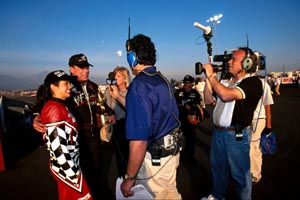 At the conclusion of the Funny Car finals, driver Jerry Toliver, a 49-year-old from Huntington Beach, Calif., emerged from his hot rod and immediately thanked a list of companies that sponsor his car. It was a stunning move that may set a precedent for the entire world of auto racing.
At the conclusion of the Funny Car finals, driver Jerry Toliver, a 49-year-old from Huntington Beach, Calif., emerged from his hot rod and immediately thanked a list of companies that sponsor his car. It was a stunning move that may set a precedent for the entire world of auto racing.
"It just came out," Toliver said. "Normally I say, 'Hi mom' or 'Whassup' but this time I just started talking about my sponsors. I don't know what hit me.”
Experts in the industry immediately began to analyze the breaking developments. "By thanking these companies on live television he could actually be giving them some exposure," said Ray Tings from the National Institute of Facts and Figures. "We find this idea quite interesting." (Read full story)
(Note: If you followed that link, you can see that I am linking back to very old versions of NHRA.com, which also included funny fake navigation labels on the left. Other links below also will be to very old archived pages so don't expect any of the side links to still work or be valid.)
 My response to the Toliver piece was a prototypical Onion “Duh!”-type story titled "Teams prefer big tires on the back (round ones, too)," which included quotes from the likes of (read the names aloud to yourself) Cy Dwalls and Phil D'Withaire:
My response to the Toliver piece was a prototypical Onion “Duh!”-type story titled "Teams prefer big tires on the back (round ones, too)," which included quotes from the likes of (read the names aloud to yourself) Cy Dwalls and Phil D'Withaire:
By an overwhelming margin of more than 99 percent, top race teams on the NHRA Winston Drag Racing Series report that they prefer to mount their biggest, widest tires on the rear of their race vehicles. Additionally, race teams expressed an almost fanatical preference for round tires.
These conclusions are the result of a poll of 2,000 race teams in all classes of NHRA competition conducted during the season's first three races, and defines a trend that is not expected to reverse itself unless the cars do.
"We've poured a lot of research and development time and money into the classic round design," said tire-industry expert Ray Deehl. "It's very gratifying because the round shape was not the first design; we, of course, had that rocky period with the oval-shaped tires and I'd just as soon not discuss the 'Square Years' unless I have to." (Read full story)
After the success of that initial 1998 story, Billups worked with us for a few more years, coming up with more wild ideas like a three-wheeled Top Fueler:
 In the first major evolutionary design change to a Top Fuel dragster since "Big Daddy" Don Garlits' successful rear-engined entry, fledgling Southern California fuel pilot and noted aerodynamicist Trey Wheeler has developed a tricycle-like configuration that he recently put its early shake-down runs at a private test session at Pomona Raceway.
In the first major evolutionary design change to a Top Fuel dragster since "Big Daddy" Don Garlits' successful rear-engined entry, fledgling Southern California fuel pilot and noted aerodynamicist Trey Wheeler has developed a tricycle-like configuration that he recently put its early shake-down runs at a private test session at Pomona Raceway.
"Drag racing already is well familiar with the power of three," expounded Wheeler, who possesses a trio of degrees in engineering from Three Rivers University. "How many amber bulbs on the Christmas Tree? Three. How many decimals do we calculate elapsed time? Three. How many days do Top Fuelers runs at an event? Three. How many letters are there in NHRA? Um, I mean … never mind. I've made my point." (Read full story)
The stories went from the sublime (Schumacher admits: 'I drive with my eyes closed') to the ridiculous (Bazemore admits: 'I love the Easter Bunny') to the unthinkable (Force vows 'Era of Silence') and the, well, unusual: a driver profile on Donald Trump (remember this was back in 2008). The Bernstein family tradition of saluting crew members and sponsors with a traditional "Hats off to …” quote led to the very funny Geiger-penned story Rookie driver Brandon Bernstein very close to running out of hats. There also was a great article (that I can't find) that was supplied by the staff at Summit Motorsports Park of a transparent tunnel they were going to build over the track that would allow them to run in the rain. It came with an amazing PhotoShopped image that lent to its believability.
A couple of other articles were either so believably written (or the readers so naïve; I prefer the former) that they generated amazing response.
 A story about NHRA remaking the Wally trophy to feature Kenny Bernstein instead of honoring NHRA founder Wally Parks was not well received by the faithful who flooded NHRA with emails (fortunately they all come through me) complaining about displacing Wally (even though, of, ol’ W.P. was not the model for the iconic statuette).
A story about NHRA remaking the Wally trophy to feature Kenny Bernstein instead of honoring NHRA founder Wally Parks was not well received by the faithful who flooded NHRA with emails (fortunately they all come through me) complaining about displacing Wally (even though, of, ol’ W.P. was not the model for the iconic statuette).
Another article, a riff on those all-too-common “Nigerian prince” emails we all get, titled "Nigerian business proposal stokes Funny Car dreams," told the story of a would-be racer (we used a funny photo of nitro bon vivant “Berserko Bob” Doerrer as our fictional racer) whose nitro dreams were about to come true if only he supplied his benevolent email friend with his banking information. It, too, drew lots of email begging us to warn the racer that this was a scam.
Finally (and I’m just citing a few of the nearly 30 stories we concocted), there’s my personal favorite, in which I exposed “Aussie Dave” Grubnic as actually being from Southern California, complete with a fake birth certificate and more Australian lingo than you can shake a dingo at.
All in all, a lot of good fun was had. Maybe someday we can revisit the idea.

Speaking of revisiting and things to come, I had originally planned for this column to be a Pure Hell-themed addition to the Dale Emery memories as well as a salute to the recently lost Funny Car chassis builder/team owner Steve Plueger, but the pieces for both didn't come together in time to make the deadline, but I'll get to them in the weeks ahead.
Thanks again for reading. See you next week.
Phil Burgess can reached at pburgess@nhra.com



























